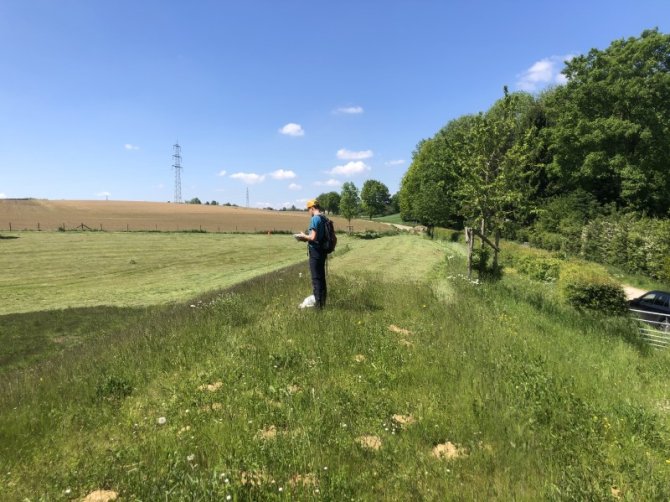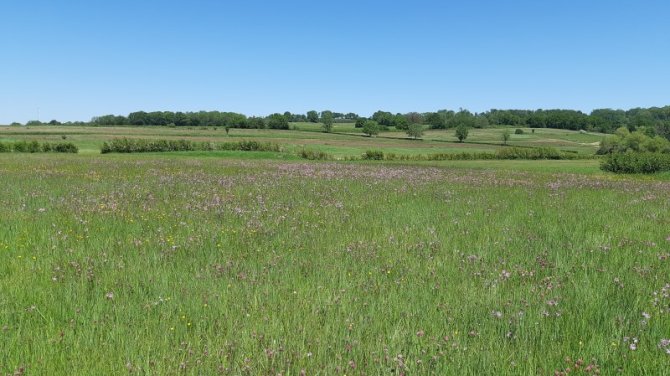The University Fund Wageningen focuses on biodiversity this month. The pressing question is: could life on Earth exist without biodiversity? One of the projects the fund supports within this campaign is Nature Recovery in Southern Limburg, an initiative by David Kleijn and Philippine Vergeer, professor and associate professor, respectively, of Plant Ecology and Nature management at Wageningen University & Research.
'Nature areas are fragmented, sometimes fenced and delineated by a ditch. Intensive agriculture starts on the other side of the ditch. That is how we humans have designed it: wild animals and plants here, farmland and cows there. But that is not how it works. The fragmentation prevents animals from roaming freely, and plants from growing where they naturally would, while it is precisely that which is needed for cross-pollination and genetic variation', says David Kleijn.
Minor interventions
This must change, the researchers thought, and they started to seek ways to interlink nature and other uses of space. They sat down with various stakeholders (farmers' organisations, municipalities, nature protection organisations, the water authorities, waterworks and the province) four years ago for the first time to discuss how the landscape might be designed differently through minor interventions rather than with drastic, costly changes.

Recovering natural gradients, the transition between areas of nature and cultivation is an example. The parties agreed that field margins, hedges and verges in agricultural areas were to be ecologically managed so that they could function as a link between the fragmented plots of nature. The hilly countryside of Southern Limburg is exceptionally suited for this type of intervention as it historically contains lynchets, earth terraces with permanent vegetation that result from erosion or have been constructed by farmers wishing to level their fields.
Bee-friendly management
The bee-friendly management of water buffers and natural meadows is another such example. This means the fields are mowed in stages so that there are always some flowers throughout the season. David Kleijn: 'This may appear a small intervention, but once you start to discuss it, you discover how complicated everything is organised in the Netherlands. There are always multiple parties that are involved-for example, not just the farmer but also the lessor and the water authority.
A project such as this reveals how complicated things are organised in the Netherlands
The fact remains that most parties are very affable. The fact that measures to counter the loss of biodiversity are necessary is widely accepted. Nature has already proven to be very resilient. The shrill carder bee, for example, returned to the Limburg, and the bee population has demonstrably increased in recent years.
Unique and complex ecosystem
The ecosystem within which the study is set -the Geuldal, between Valkenburg and Gulpen- is, like many ecosystems, unique and complex. Plants that depend on the specific local circumstances, such as calcium in the soil and calcium-rich expelled groundwater, grow there. The researchers want to reintroduce larger populations of these species into the landscape. 'However,' says Philippine Vergeer, 'this requires detailed knowledge of the ecosystem. If these so-called abiotic factors (calcium, seep) are lacking, these plant species will not occur, so there is no point in simply planting them somewhere in the verges.'

The project is not yet finished. 'The project is only completed when the population of wild bees is permanently increased in size and diversity', says David. 'You must be able to prove that the increased biodiversity is the result of your intervention to show that certain measures are necessary to increase biodiversity sustainably. And, above all, you want the idea of biodiversity to become firmly entrenched within the area's inhabitants' way of thinking. Only when biodiversity becomes everyone's concern can we prevent the most cost-effective management methods from being selected time and again. A wealth of flora is an excellent indicator of the state of nature. If the area is suitable for bees, it is also suitable for many other species.'
You want the idea of biodiversity to become firmly entrenched within the inhabitants' way of thinking
The University Fund Wageningen is a proud supporter of initiatives such as these. There are also other studies that could benefit from UFW funding. You, too, could make an impact on biodiversity in the Netherlands. Support the University Fund Wageningen and contribute to the recovery of nature in the Netherlands.






